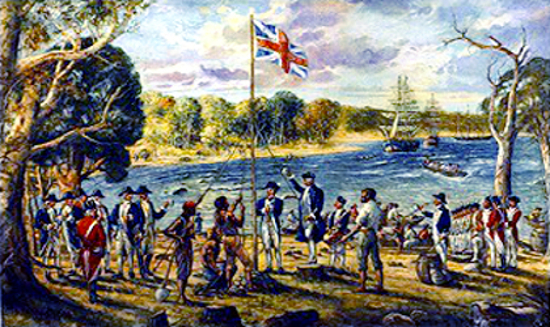Project Description
1788-1808
Australia’s history of European settlement began with the formal establishment of the Sydney colony on 26th January, 1788.
This painting depicts the site of the First Landing, where Captain Arthur Phillip proclaimed the colony of New South Wales at Sydney Cove, on that date.
The First Fleet was the name given to the eleven ships which transported the first 1,487 colonists to Australia. It consisted of six charted merchant vessels to contain the convicts and three storage ships, escorted by two naval vessels, seen docked off-shore to the right of the painting; the flagship H.M.S. Sirius, commanded by Phillip, and the armed tender H.M.S. Supply, commanded by Lieutenant Henry Ball. They departed from Portsmouth, England, on 13th May, 1787, and took eight months and one week to complete the voyage to Australia.
Sailing into Port Jackson at around 7pm on 25th January, 1788, the Supply was the first naval ocean-cruising ship to enter Sydney Harbour. She anchored at Sydney Cove to await the arrival of the other vessels, which followed on the next day.
On 26th January, with all eleven ships safely anchored in Sydney Cove, work parties disembarked and began to clear a site by the stream. It was a scene of “every man stepping from the boat literally into a wood”.
An important formal ceremony took place that evening, the event recorded by David Collins (who was to become the colony’s first law-maker):
“In the evening of this day the whole party that came round in the Supply were assembled at the point where they had first landed in the morning. and on which a flagstaff had been purposely erected and a Union Jack displayed, when the marines fired several volleys, between which the Governor and the officers who accompanied him drank the health of his Majesty and the Royal Family and success to the new colony.”
The flag raised in the painting does not have the Red Cross of today’s Union Jack since this feature wasn’t added until the union with Ireland in 1801.
With the unfurling of the Union Jack, and the four toasts – the first to the health of King George Ill, the second to Queen Charlotte of Mecklengurg-Streiitz, the third to George, Prince of Wales, and the fourth to the colony’s success, the colony of New South Wales was officially proclaimed. Ever since, 26th January has been celebrated, originally as “Anniversary Day”, and now as “Australia Day”.
After this small ceremony, the work began; Captain-Lieutenant Watkin Tench reported in his personal journal:
The landing of a part of the marines and convicts took place the next day, and on the following, the remainder was disembarked. In one place, a party cutting down the woods: a second, setting up a blacksmith’s forge; a third. dragging along a load of stones or provisions: here an officer pitching his marquee, with a detachment of troops parading on one side of him. and a cook’s fire blazing up on the other.
Trees were cut down and dragged away, tents pitched in the clearings, wattle-and-daub huts constructed to contain stores, and special first-aid shelters built for the sick, since illness had just broken out.
